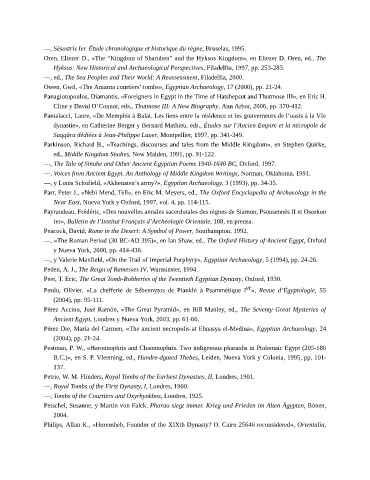Page 724 - Auge y caída del antiguo Egipto
P. 724
—, Sésostris Ier. Étude chronologique et historique du règne, Bruselas, 1995.
Oren, Eliezer D., «The “Kingdom of Sharuhen” and the Hyksos Kingdom», en Eliezer D. Oren, ed., The
Hyksos: New Historical and Archaeological Perspectives, Filadelfia, 1997, pp. 253-283.
—, ed., The Sea Peoples and Their World: A Reassessment, Filadelfia, 2000.
Owen, Gwil, «The Amarna courtiers’ tombs», Egyptian Archaeology, 17 (2000), pp. 21-24.
Panagiotopoulos, Diamantis, «Foreigners in Egypt in the Time of Hatshepsut and Thutmose III», en Eric H.
Cline y David O’Connor, eds., Thutmose III: A New Biography, Ann Arbor, 2006, pp. 370-412.
Pantalacci, Laure, «De Memphis à Balat. Les liens entre la résidence et les gouverneurs de l’oasis à la VIe
dynastie», en Catherine Berger y Bernard Mathieu, eds., Études sur l’Ancien Empire et la nécropole de
Saqqâra dédiées à Jean-Philippe Lauer, Montpellier, 1997, pp. 341-349.
Parkinson, Richard B., «Teachings, discourses and tales from the Middle Kingdom», en Stephen Quirke,
ed., Middle Kingdom Studies, New Malden, 1991, pp. 91-122.
—, The Tale of Sinuhe and Other Ancient Egyptian Poems 1940-1640 BC, Oxford, 1997.
—, Voices from Ancient Egypt. An Anthology of Middle Kingdom Writings, Norman, Oklahoma, 1991.
—, y Louis Schofield, «Akhenaten’s army?», Egyptian Archaeology, 3 (1993), pp. 34-35.
Parr, Peter J., «Nebi Mend, Tell», en Eric M. Meyers, ed., The Oxford Encyclopedia of Archaeology in the
Near East, Nueva York y Oxford, 1997, vol. 4, pp. 114-115.
Payraudeau, Frédéric, «Des nouvelles annales sacerdotales des règnes de Siamon, Psousennès II et Osorkon
Ier», Bulletin de l’Institut Français d’Archéologie Orientale, 108, en prensa.
Peacock, David, Rome in the Desert: A Symbol of Power, Southampton, 1992.
—, «The Roman Period (30 BC-AD 395)», en Ian Shaw, ed., The Oxford History of Ancient Egypt, Oxford
y Nueva York, 2000, pp. 414-436.
—, y Valerie Maxfield, «On the Trail of Imperial Porphyry», Egyptian Archaeology, 5 (1994), pp. 24-26.
Peden, A. J., The Reign of Ramesses IV, Warminster, 1994.
Peet, T. Eric, The Great Tomb-Robberies of the Twentieth Egyptian Dynasty, Oxford, 1930.
er
Perdu, Olivier, «La chefferie de Sébennytos de Piankhi à Psammétique I », Revue d’Égyptologie, 55
(2004), pp. 95-111.
Pérez Accino, José Ramón, «The Great Pyramid», en Bill Manley, ed., The Seventy Great Mysteries of
Ancient Egypt, Londres y Nueva York, 2003, pp. 61-66.
Pérez Die, María del Carmen, «The ancient necropolis at Ehnasya el-Medina», Egyptian Archaeology, 24
(2004), pp. 21-24.
Pestman, P. W., «Haronnophris and Chaonnophris. Two indigenous pharaohs in Ptolemaic Egypt (205-186
B.C.)», en S. P. Vleeming, ed., Hundre-dgated Thebes, Leiden, Nueva York y Colonia, 1995, pp. 101-
137.
Petrie, W. M. Flinders, Royal Tombs of the Earliest Dynasties, II, Londres, 1901.
—, Royal Tombs of the First Dynasty, I, Londres, 1900.
—, Tombs of the Courtiers and Oxyrhynkhos, Londres, 1925.
Petschel, Susanne, y Martin von Falck, Pharao siegt immer. Krieg und Frieden im Alten Ägypten, Bönen,
2004.
Philips, Allan K., «Horemheb, Founder of the XIXth Dynasty? O. Cairo 25646 reconsidered», Orientalia,

